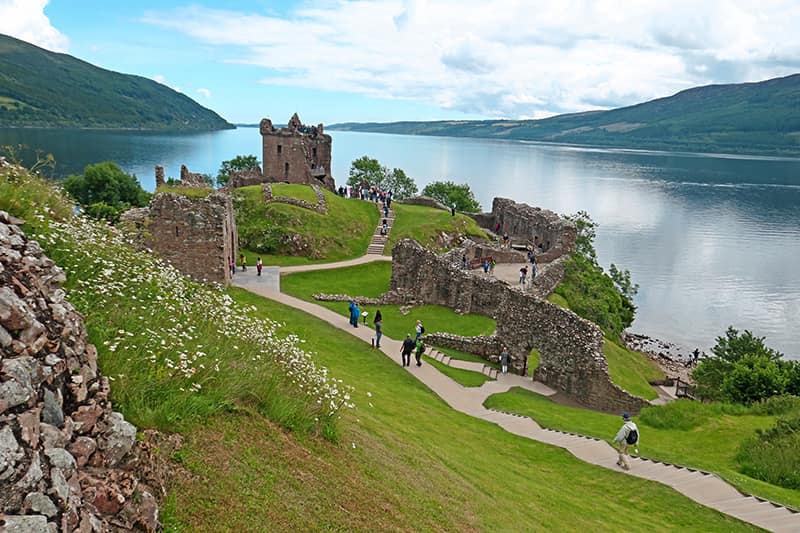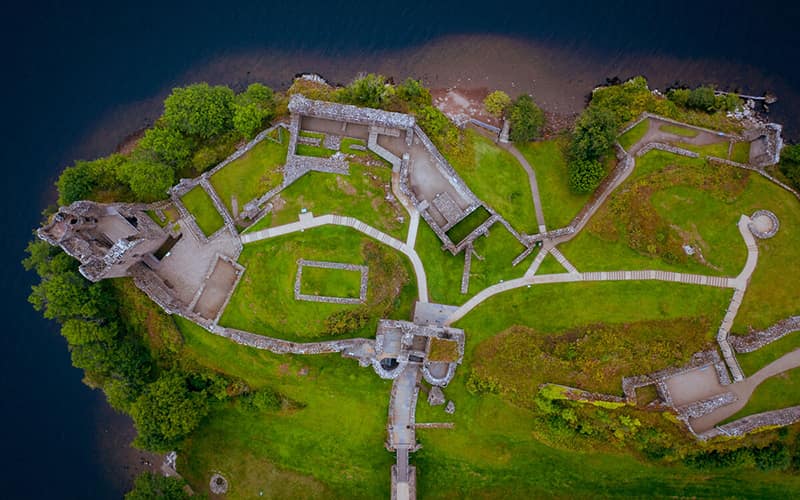Scotland is famous for its extensive landscapes, magnificent lochs and secluded castles, and if you’re searching for all three, then you need look no further than Urquhart Castle. Situated beside Loch Ness, these inspiring ruins look as though they’re gradually crumbling into the inky-blue depths of this world-famous loch.
Exploring Urquhart Castle, a Highlight of the Scottish Highlands

Where is Urquhart Castle?
Urquhart Castle is situated on the banks of Loch Ness, 21km south-west of Inverness. The fortress occupies a headland near Drumnadrochit and is surrounded by stunning highland views and vistas of the loch, or lake.
What is Urquhart Castle famous for?
Urquhart Castle is around 800 years old. Its location was chosen for its advantageous position on a rocky precipice foreshadowing Loch Ness. With incredible vistas of the surrounding area, Urquhart Castle’s position allowed the alarm to be raised when the castle was at risk of attack.
Steeped in history, Scotland’s Urquhart Castle was at the centre of the 500 years of battles for Scottish independence. Under the control of Robert the Bruce, King of Scots, during the 1300s, Urquhart was continually under threat of invasion from the English.
Urquhart Castle’s best defence was by drawbridge and ditch, though the glen was still raided many times by the Lords of Islay, who belonged to the MacDonald clan. Changing allegiances meant that during the Middle Ages, Urquhart passed hands many times between the English and Scottish.
The castle’s tumultuous history ended when the gatehouse was blown up during the Jacobite Risings of the seventeenth century. The Grant Tower is now the most iconic part of the castle still standing and can be seen for miles around.

History of Urquhart Castle
The present Urquhart Castle was founded in the thirteenth century but is built on the remains of much earlier buildings that date as far back as the 500s. Radiocarbon dating has proven that there was a huge fort on the south-west corner of the site between the 5th and 11th centuries.
The history of Scotland’s Urquhart Castle really began when Alexander II granted the fortress to his usher, Thomas de Lundin, in the thirteenth century. The present building was built by his son, Alan Durwin, and the fortress centred on a traditional motte castle. After the castle changed hands, Edward I of England invaded, laying siege to Urquhart in 1296. This monumental event marked the beginning of the Wars of Scottish Independence.
The Scottish Wars of Independence
At the beginning of the 1300s, the castle had been entrusted to the Comyn family, who sided with the English against Robert the Bruce, King of the Scots. In 1306, Bruce swept through the Great Glen, taking the castles of Inverlochy, Urquhart and Inverness. With his humiliation of the Comyns complete, Urquhart became a royal castle and was held for the crown by a series of constables.
In 1333, the Scots were defeated by English forces at the Battle of Halidon Hill. During this period, Urquhart Castle was one of only five fortresses held by Scottish forces and King David II chose to stay in the summer of 1342. The Scottish Wars of Independence came to a close in 1357, though Urquhart Castle’s dramatic history was far from over.

The Grants and the MacDonalds
Over the next two hundred years, Scotland’s Urquhart Castle consistently raided by the MacDonald lords. This powerful family had historically held the earldom of Ross and ruled a semi-independent kingdom in west Scotland.
Starting in 1395, the Castle was taken from the Crown by Donald, Lord of the Isles. Though it was taken back after the Battle of Harlaw in 1411, the fighting did not end there. Donald’s son led several raids on the castle with little success. Nevertheless, the MacDonalds again seized control in 1452 under John of Islay, who was awarded a grant to the castle and its lands for life. However, when John made an alliance with Edward IV of England, James III stripped him of his titles and Urquhart Castle.
From the 1500s, Sir Duncan Grant of Freuchie took charge of the castle. In Freuchie’s hands until 1512, the tides turned after a Scottish defeat to England at the Battle of Flodden Field. In an attempt to claim back the Lordship of the Isles, Sir Donald MacDonald occupied Urquhart Castle. Although the castle was taken back by the Grants, the MacDonalds had already looted it. As a result, the Grants joined forces with the Huntly family and Clan Fraser in 1544 against the MacDonalds of Clanranald. After the Battle of the Shirts, the Macdonalds and their allies took back Urquhart castle and again raided the lands for cattle, furniture, cannons and even the gates!
The Grants improved Urquhart Castle’s defences to protect against future Macdonald raids, though they lived there very little from the 1600s. In 1644, a mob broke into the castle and robbed Lady Mary Grant, resulting in the Grants moving out with most of their belongings.
The castle saw its last battle in 1688 when the Catholic King of Britain, James II, was deposed in favour of William of Orange. Ludovic Grant garrisoned the fortress with 200 of his own soldiers against a force of 500 of James II’s men. When the James II’s main Jacobite force was defeated at Cromdale, Grant’s men left Urquhart and blew up the gate house to prevent Jacobites from occupying the building. Its stone was plundered and reused in nearby buildings and a storm destroyed part of the Grant Tower in 1715.
What can you see at Urquhart Castle?
Today, Urquhart castle is mostly a romantic ruin. It is one of the largest castles in Scotland and is built in a shape that’s been likened to a figure of 8. Its ruins include Grant Tower and the remains of a dry moat which measures thirty metres across at its widest.
Visitors can head to Urquhart Castle’s visitor centre to see some of the artefacts that were found on the site, including a fifteenth century bronze ewer, coins, jewellery, crosses and other items from the 1300s to late 1600s. Don’t miss the full-sized Trebuchet near the ruins of Urquhart Castle and the gloomy prison cell, that is said to have held the Gaelic bard, Dòmhnall Donn!
You can see everything there is to see at Urquhart Castle in a couple of hours. If you’re particularly patient, you never know, you may even catch a glimpse of the Loch Ness monster!
Cruise alongside Urquhart Castle
Why not enjoy views of Loch Ness, Urquhart Castle and the Scottish Highlands on a European Waterways cruise aboard the 12-passenger Spirit of Scotland or the 8-passenger Scottish Highlander cruising the Great Caledonian Canal and Loch Ness. For more information about our Scotland cruises, order a free copy of our brochure or speak to a member of our team via our handy Contact Form.
 English
English
 Spanish
Spanish French
French German
German Norwegian
Norwegian Portuguese
Portuguese Swedish
Swedish Italian
Italian Russian
Russian Simplified Chinese
Simplified Chinese Japanese
Japanese